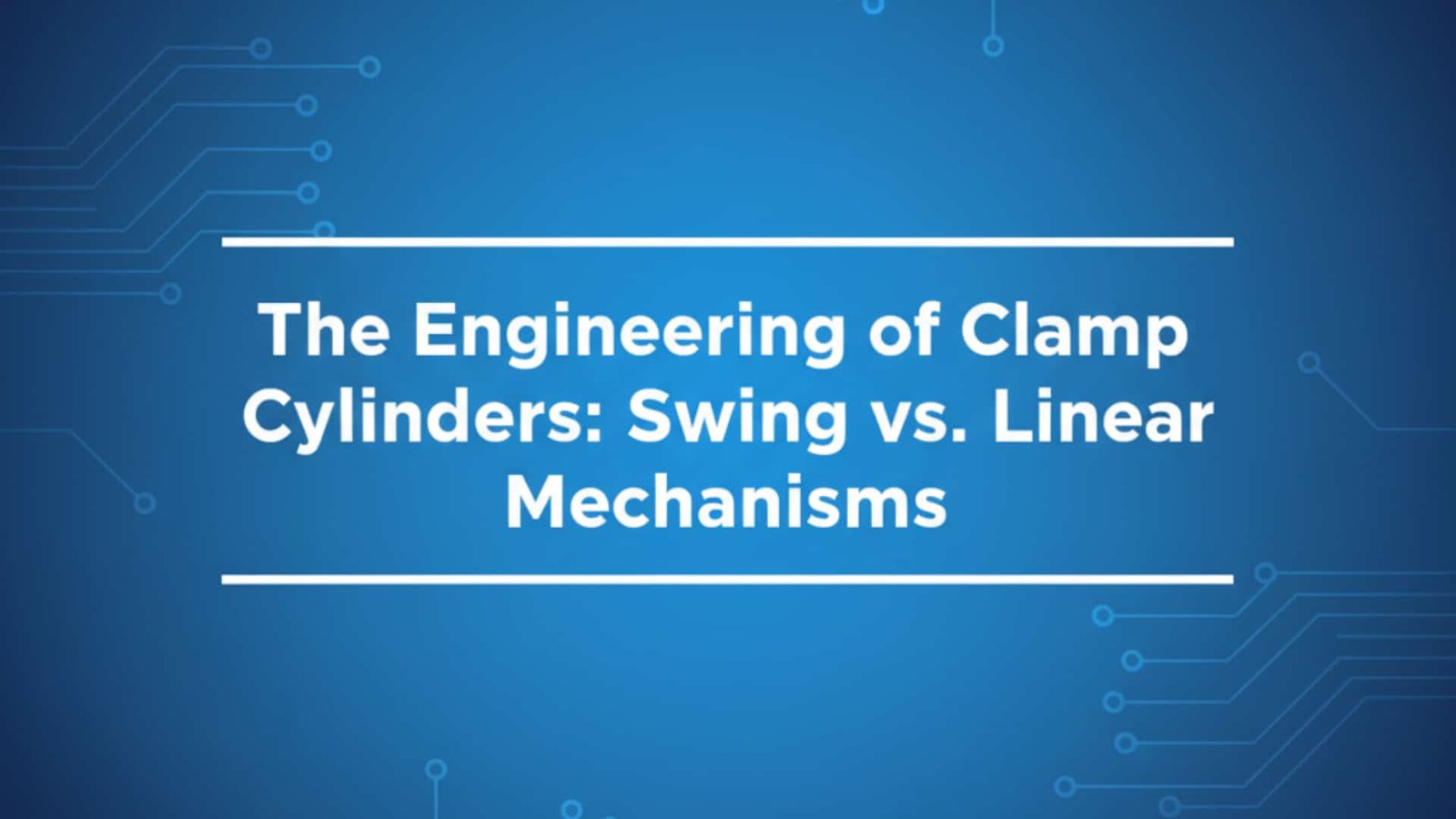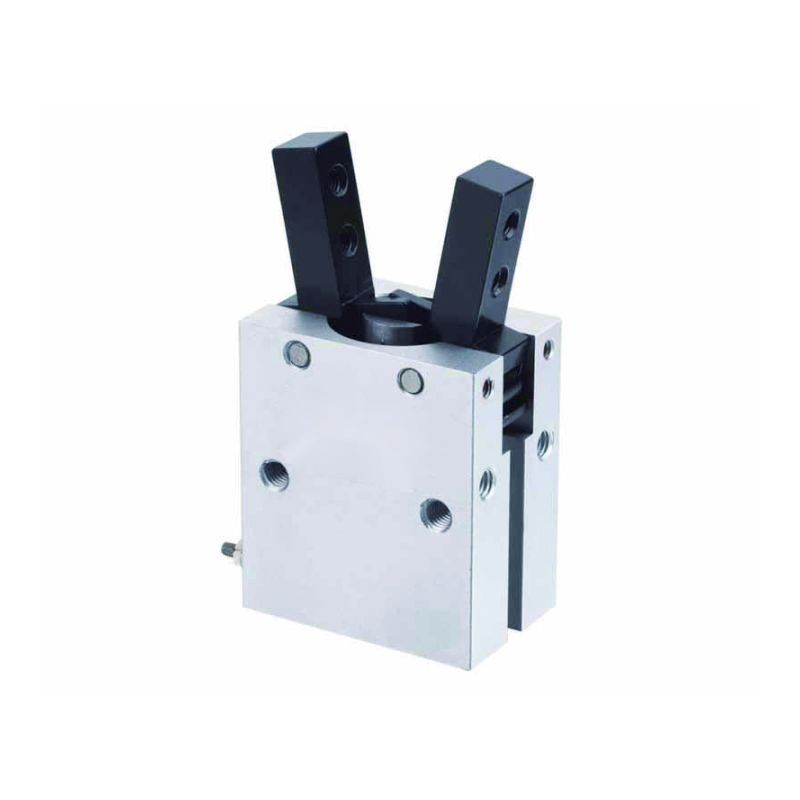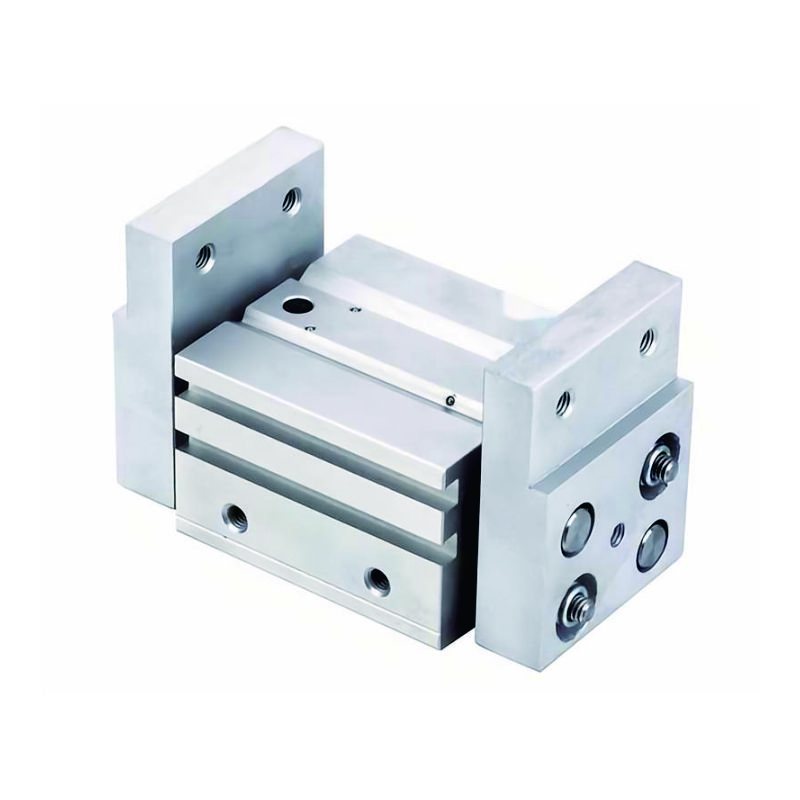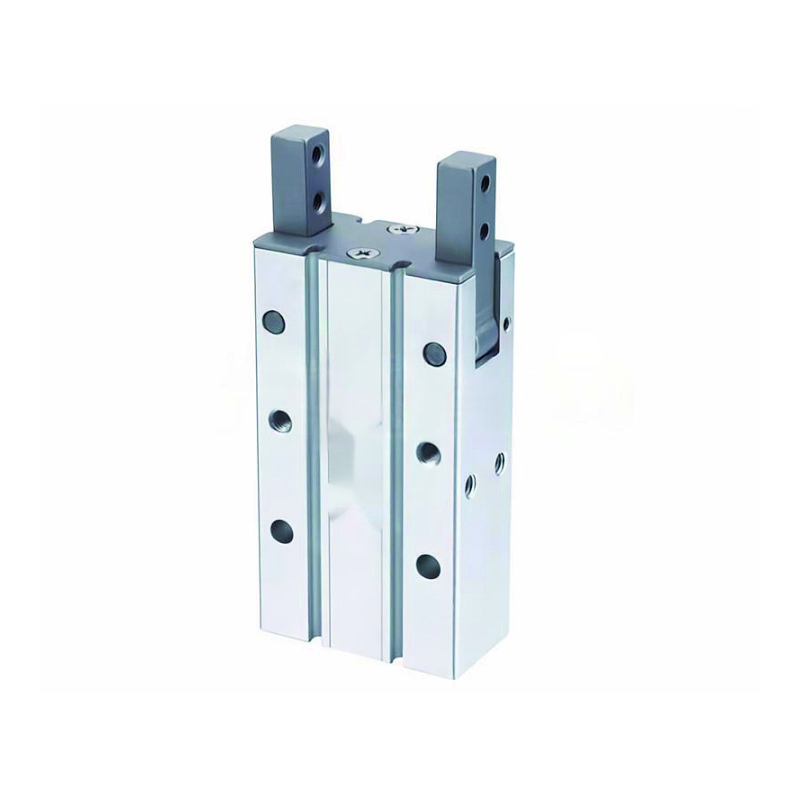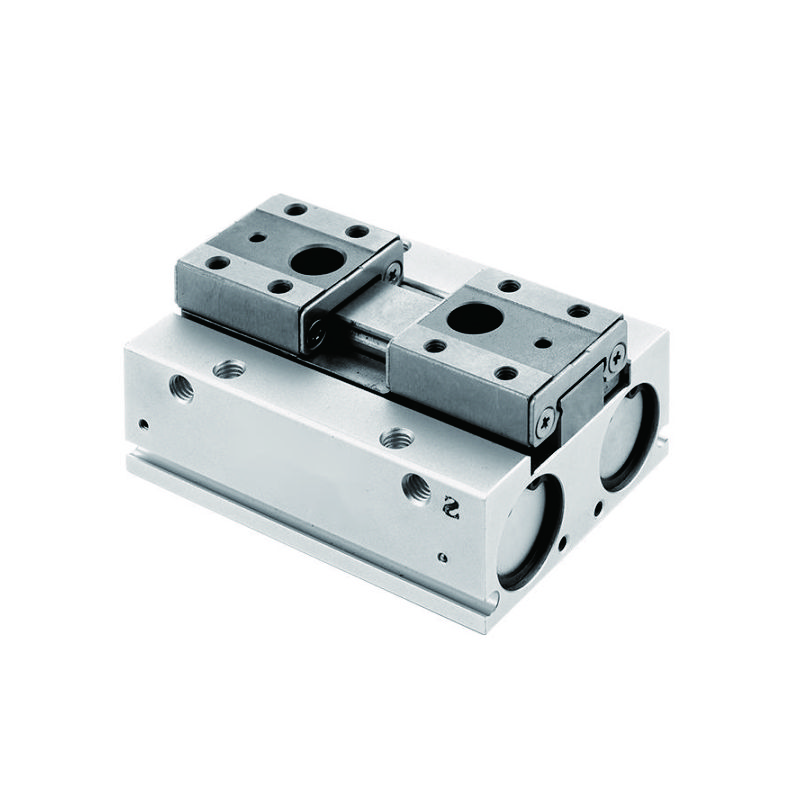Clamp cylinder selection mistakes cost manufacturers thousands in productivity losses, component damage, and safety incidents. Wrong mechanism choices lead to insufficient clamping force, excessive wear, and unreliable workpiece positioning that disrupts entire production schedules and quality standards.
Clamp cylinder engineering involves choosing between swing mechanisms that provide rotational clamping motion with compact design and linear mechanisms offering direct force application, with selection based on space constraints, force requirements, positioning accuracy, and application-specific mounting configurations.
Yesterday, I spoke with Robert, a production manager at an aerospace parts manufacturer in Seattle, whose assembly line was experiencing 15% scrap rates due to workpiece movement during machining caused by inadequate clamping force from improperly selected cylinders. 😤
Table of Contents
- What Are the Fundamental Design Differences Between Swing and Linear Clamp Cylinders?
- How Do Force Characteristics Compare Between Swing and Linear Clamping Mechanisms?
- What Space and Mounting Considerations Determine Clamp Cylinder Selection?
- Which Applications Benefit Most from Swing vs Linear Clamp Cylinder Designs?
What Are the Fundamental Design Differences Between Swing and Linear Clamp Cylinders? ⚙️
Understanding the core mechanical principles helps engineers select the optimal clamping solution for their applications.
Swing clamp cylinders use rotational motion through pivot mechanisms to create clamping force via lever arms, while linear clamp cylinders apply direct force through straight-line piston movement, each offering distinct advantages in force multiplication, space utilization, and positioning accuracy for industrial clamping applications.
Swing Clamp Mechanism Design
Rotational clamping systems that utilize pivot points and lever arms for force application.
Swing Clamp Components
- Pivot housing: Contains bearing assembly for smooth rotational movement
- Clamp arm: Lever mechanism that multiplies applied force
- Actuator cylinder: Provides linear motion converted to rotational movement
- Locking mechanism: Ensures secure clamping position under load
Linear Clamp Architecture
Direct-acting systems that apply clamping force through straight-line motion.
| Design Aspect | Swing Clamp | Linear Clamp | Key Difference |
|---|---|---|---|
| Motion type | Rotational | Linear | Force application method |
| Force multiplication | Lever advantage | Direct transfer | Mechanical advantage |
| Space requirement | Compact footprint | Longer stroke length | Installation envelope |
| Positioning accuracy | Arc-based | Straight-line | Movement precision |
Mechanical Advantage Principles
How each design type achieves force multiplication and positioning control.
Force Multiplication Methods
- Swing systems: Leverage ratio1 determines force multiplication factor
- Linear systems: Direct force transfer with optional mechanical advantage
- Efficiency factors: Bearing friction and seal resistance affect output
- Force consistency: Maintaining clamping force throughout stroke range
Actuation Methods
Different approaches to powering clamp cylinder movement and control.
Actuation Options
- Pneumatic: Most common for general industrial applications
- Hydraulic: High-force applications requiring maximum clamping power
- Electric: Precise positioning and programmable force control
- Manual: Backup systems for maintenance and emergency operations
Design Complexity Considerations
Engineering factors that influence manufacturing cost and maintenance requirements.
Complexity Factors
- Component count: Number of parts affecting reliability and cost
- Manufacturing precision: Tolerance requirements for proper operation
- Assembly procedures: Installation complexity and alignment requirements
- Maintenance access: Serviceability and component replacement ease
Robert’s aerospace facility was using linear clamps in tight spaces where swing clamps would have provided better clearance and more reliable clamping force, leading to workpiece shifting during precision machining operations. 🔧
How Do Force Characteristics Compare Between Swing and Linear Clamping Mechanisms? 💪
Force generation and application differ significantly between swing and linear clamp designs, affecting performance and suitability.
Swing clamp mechanisms provide variable force multiplication through lever arms with ratios typically ranging from 2:1 to 6:1, while linear clamps deliver consistent direct force throughout their stroke, with swing clamps offering higher peak forces and linear clamps providing more predictable force characteristics.
Force Multiplication Analysis
Understanding how each mechanism type generates and applies clamping force.
Swing Clamp Force Characteristics
- Lever ratio: Mechanical advantage typically 3:1 to 5:1 for most applications
- Force variation: Maximum force at optimal arm angle, reduced at extremes
- Torque considerations: Rotational force creates holding torque at clamp point
- Force direction: Clamping force angle changes throughout swing arc
Linear Clamp Force Profile
Direct force application characteristics and consistency throughout stroke.
Linear Force Benefits
- Consistent force: Uniform clamping pressure throughout entire stroke
- Predictable performance: Force output directly proportional to input pressure
- Direction control: Force applied in precise, controlled direction
- Force feedback: Easier to monitor and control actual clamping force
Pressure-to-Force Conversion
Calculating actual clamping force from system pressure for both designs.
| Cylinder Bore | System Pressure | Linear Force | Swing Force (4:1 ratio) | Advantage |
|---|---|---|---|---|
| 32mm | 6 bar | 483N | 1,932N | Swing 4:1 |
| 50mm | 6 bar | 1,178N | 4,712N | Swing 4:1 |
| 80mm | 6 bar | 3,015N | 12,060N | Swing 4:1 |
| 100mm | 6 bar | 4,712N | 18,848N | Swing 4:1 |
Force Control Methods
Different approaches to managing and controlling clamping force application.
Control Strategies
- Pressure regulation: Controlling input pressure for desired output force
- Force feedback: Monitoring actual clamping force through sensors
- Position control: Precise positioning for consistent clamping geometry
- Safety systems: Force limiting to prevent workpiece or tooling damage
Dynamic Force Considerations
How moving loads and vibration affect clamping force requirements.
Dynamic Factors
- Machining forces2: Cutting forces that must be overcome by clamping
- Vibration resistance: Maintaining clamp integrity under dynamic loads
- Acceleration forces: Clamping requirements during rapid machine movements
- Safety margins: Additional force capacity for unexpected load variations
Force Optimization Strategies
Maximizing clamping effectiveness while minimizing system requirements.
Optimization Approaches
- Multiple clamps: Distributing forces across multiple clamping points
- Clamp positioning: Strategic placement for optimal force distribution
- Sequence control: Coordinated clamping for complex workpiece geometries
- Force monitoring: Real-time feedback for process optimization
What Space and Mounting Considerations Determine Clamp Cylinder Selection? 📐
Physical constraints and mounting requirements significantly influence clamp cylinder design selection.
Space and mounting considerations include envelope dimensions, with swing clamps requiring rotational clearance but compact mounting footprints, while linear clamps need straight-line clearance but offer flexible mounting orientations, making selection dependent on available space, accessibility requirements, and integration with existing machinery.
Envelope Requirements
Understanding space requirements for each clamp type in different orientations.
Space Considerations
- Swing clearance: Rotational arc requires unobstructed space around pivot
- Linear stroke: Straight-line movement needs clear path for full extension
- Mounting depth: Base mounting requirements for secure installation
- Service access: Space needed for maintenance and adjustment procedures
Mounting Configuration Options
Different mounting methods available for various installation scenarios.
Mounting Types
- Base mounting: Standard bottom-mount configuration for stable installation
- Side mounting: Vertical installation for space-constrained applications
- Inverted mounting: Upside-down installation for overhead applications
- Custom brackets: Application-specific mounting solutions
Integration Challenges
Common obstacles when incorporating clamp cylinders into existing systems.
| Challenge | Swing Clamp Solution | Linear Clamp Solution | Best Choice |
|---|---|---|---|
| Limited height | Compact profile | Requires stroke clearance | Swing |
| Tight side clearance | Needs arc clearance | Minimal side space | Linear |
| Multiple orientations | Fixed pivot point | Flexible mounting | Linear |
| High force in small space | Lever advantage | Direct force only | Swing |
Accessibility Requirements
Ensuring proper access for operation, maintenance, and troubleshooting.
Access Considerations
- Manual override: Emergency manual operation capability
- Adjustment access: Easy reach for force and position adjustments
- Maintenance clearance: Space for component replacement and service
- Visual monitoring: Line of sight for operational status verification
Interference Prevention
Avoiding conflicts with other machine components and tooling.
Interference Factors
- Tool clearance: Avoiding contact with cutting tools and fixtures
- Workpiece access: Maintaining clear access for part loading/unloading
- Cable routing: Managing pneumatic lines and electrical connections
- Safety zones: Ensuring operator safety during clamping operations
Modular Design Benefits
How modular clamp systems address space and mounting challenges.
Modular Advantages
- Standardized interfaces: Common mounting patterns for easy installation
- Scalable solutions: Multiple sizes using same mounting footprint
- Interchangeable components: Easy upgrades and modifications
- Reduced inventory: Fewer unique parts for maintenance stock
At Bepto, we provide comprehensive mounting solutions and space-saving designs that help customers optimize their clamping systems for maximum efficiency in constrained spaces. 🎯
Which Applications Benefit Most from Swing vs Linear Clamp Cylinder Designs? 🏭
Different industrial applications favor specific clamp cylinder designs based on operational requirements.
Swing clamp cylinders excel in machining centers, assembly fixtures, and welding applications requiring high clamping forces in compact spaces, while linear clamp cylinders perform best in material handling, packaging, and precision positioning applications where consistent force and straight-line motion are critical.
Machining and Manufacturing Applications
How different clamp types serve various manufacturing processes.
Swing Clamp Applications
- CNC machining: High-force workpiece clamping for heavy cutting operations
- Welding fixtures: Secure positioning for consistent weld quality
- Assembly operations: Component positioning during fastening procedures
- Quality inspection: Workpiece restraint during measurement and testing
Material Handling Systems
Clamp cylinder applications in automated material movement and positioning.
Linear Clamp Applications
- Conveyor systems: Part stopping and positioning on production lines
- Packaging machinery: Product restraint during wrapping and sealing
- Sorting equipment: Item separation and routing in automated systems
- Loading systems: Part positioning for robotic handling operations
Industry-Specific Requirements
Specialized applications that favor particular clamp cylinder designs.
| Industry | Preferred Type | Key Requirements | Typical Applications |
|---|---|---|---|
| Automotive | Swing | High force, compact | Engine block machining |
| Electronics | Linear | Precision, gentle force | PCB assembly |
| Aerospace | Swing | Maximum rigidity | Aircraft part machining |
| Food processing | Linear | Sanitary design | Package handling |
Performance Optimization
Matching clamp cylinder characteristics to application demands.
Optimization Factors
- Cycle time: Speed requirements for automated operations
- Force consistency: Maintaining uniform clamping throughout process
- Positioning accuracy: Repeatability requirements for quality control
- Environmental conditions: Temperature, humidity, and contamination resistance
Cost-Benefit Analysis
Economic considerations when selecting between swing and linear designs.
Economic Factors
- Initial cost: Purchase price differences between clamp types
- Installation cost: Mounting and integration complexity
- Operating costs: Energy consumption and maintenance requirements
- Productivity impact: Effect on cycle times and throughput rates
Future Trends
Emerging developments in clamp cylinder technology and applications.
Technology Trends
- Smart clamping: Integrated sensors and feedback systems
- Energy efficiency: Reduced air consumption and power requirements
- Modular systems: Standardized components for flexible configurations
- Digital integration: IoT connectivity for remote monitoring and control
Lisa, who manages a medical device manufacturing facility in Boston, switched from linear to swing clamps on her precision machining centers and achieved 40% faster cycle times while improving part quality through more secure workpiece clamping. 📊
Conclusion
Selecting between swing and linear clamp cylinders requires careful analysis of force requirements, space constraints, and application-specific performance needs for optimal manufacturing efficiency. ⚡
FAQs About Clamp Cylinder Selection
Q: How do I calculate the required clamping force for my specific application?
Calculate clamping force by analyzing machining forces, safety factors, and workpiece geometry, typically requiring 2-3 times the maximum cutting force. Our engineering team provides detailed force calculations and recommendations based on your specific machining parameters and safety requirements.
Q: Can swing and linear clamp cylinders be used together in the same fixture?
Yes, combining swing and linear clamps often provides optimal solutions, using swing clamps for primary high-force clamping and linear clamps for secondary positioning. This hybrid approach maximizes both clamping effectiveness and operational flexibility.
Q: What maintenance differences exist between swing and linear clamp cylinders?
Swing clamps require pivot bearing maintenance and arm alignment checks, while linear clamps need seal replacement and rod alignment verification. Both types benefit from regular lubrication and pressure system maintenance for optimal performance.
Q: How do environmental conditions affect clamp cylinder selection?
Temperature extremes, moisture, and contamination influence material selection and sealing requirements, with swing clamps generally more sensitive to environmental factors. We provide environmental compatibility assessments to ensure proper clamp selection for your conditions.
Q: What are the typical service life expectations for different clamp cylinder types?
Quality swing clamps typically operate 2-5 million cycles, while linear clamps achieve 5-10 million cycles under normal conditions. Service life depends on operating pressure, cycle frequency, and maintenance practices, with our Bepto clamps designed for maximum durability.

